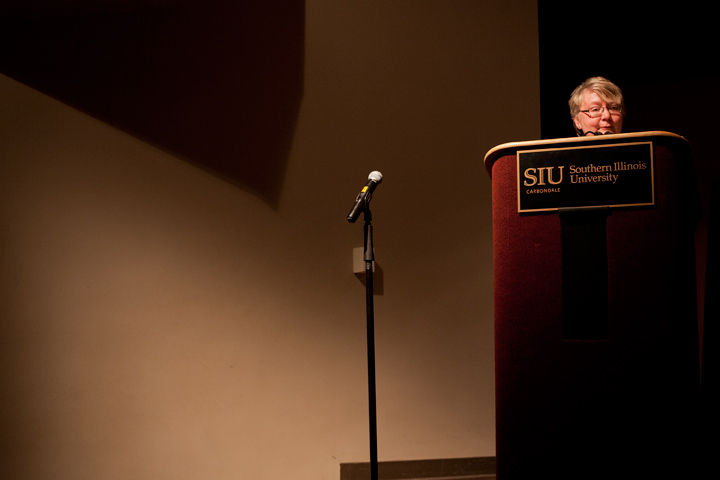OU provost shows proof of successful initiatives at chancellor forum
May 4, 2015
When Pam Benoit, the third of four finalists hoping to become the campus’ next chancellor, spoke at her open forum Monday, she presented evidence of a strategy implemented at Ohio University that increased enrollment.
Benoit, executive vice president and provost at OU, is also the sole finalist for the chancellor position at the University of Colorado Denver after two of the top three finalists withdrew, according to OU’s student-run newspaper, the Post. She visited CU Denver on April 28 and 29 for her open forum interview for the position, the paper reported on Friday.
Administrator with a plan for enrollment growth
Advertisement
Enrollment at Ohio University has increased from 30,000 to more than 38,000 since Benoit became Ohio University’s provost in July 2009, Meera Komarraju, co-chair of the chancellor search committee, said during her introduction of the finalist.
Benoit said OU created a five-year enrollment plan for students, including transfers, ones from out-of-state, in-state and community college students. To better recruit people attending community college, Benoit said Ohio University places “relationship managers” on the 19 campuses OU has partnerships with.
“They’re actually physically present on the community colleges so that they feel like that person is part of their staff,” she said. “And those students at the community college already feel like they are an Ohio University student. We give them the garb. … They are already ready to come to Ohio University when they are at the community college.”
Benoit said Ohio is also recruiting students “earlier than ever before.”
“One of the things that we’ve done is we’ve completely restructured our scholarship program, and now we use data analytics to try to figure out, ‘What will it take to yield a particular student?'” she said to the crowd in the Student Center Auditorium. “You can’t wait for them to come to you anymore.”
She said while SIU is on the right track, there is room for improvement when retaining students. Benoit said Ohio University has professional advisers to accomplish this.
“How do we make sure that we’re doing an early intervention to try to make sure that we’re getting to that student before they’re thinking about leaving us?” she asked the crowd. “All of those things can be done even more intensively… than you’re doing now.”
Advertisement*
Asked about strategies she would implement to improve the university’s connection to the city of Carbondale, Benoit gave examples of how OU does this, noting she meets with the mayor of Athens, Ohio, to discuss projects about cleaning the city. She said Ohio University staffers and city police patrol streets together during Halloween.
“I understand you had a Halloween project too,” Benoit said jokingly. “Together our Athens Police Department and our OU Police Department and a lot of our staff are out. … And I’ve got a walkie talkie and I’m calling in when I see something that should not be happening.”
Benoit — who earned a master’s degree in communication from Central Michigan University and a doctorate degree in communication from Wayne State University — said unfortunately, she has experience regarding budget cuts.
While it is not nearly as much as the $44 million that would be slashed from the Carbondale campus if Gov. Bruce Rauner’s budget passes the General Assembly, Benoit said $11 million was cut from OU’s state funding during her first year at Ohio. To deal with the cuts, she said administrators talked about a set of “budget principals.”
“One of the budget principals was that the academic core needed to be protected as much as possible,” she said. “All of the units were asked to prepare scenarios. … They all were asked, ‘What were the things they thought they could do that would have the least affect on students?'”
Benoit said the scenarios were then shared by spreadsheets with the entire campus, and OU held open forums to discuss the changes.
“One of the things I said to my president at the time was that I thought we needed to discuss it on campus, and his initial reaction was, ‘Are you crazy?’ … I said, ‘Yes, I really think it’s important… the campus needs to understand what we’re grappling with,'” she said. “At the end of that process one of the comments that we got back from several people was, ‘I don’t like some of the decisions that ended up being made, but I really liked the process.'”
OU’s administration took more cuts during this process, as opposed to injuring academic units, Benoit said. The university froze positions instead of eliminating faculty or taking furloughs — like SIU did in 2011— although some staffers were cut, she said.
Asked about student engagement, Benoit said she participates in open discussions with students called “pizza with the provost,” where people openly ask questions and talk about campus issues.
First generation student and mediator
While she did not speak about her personal life as much as the first two candidates, Benoit — who described herself as an optimistic realist — is a first generation college student. She said her parents saved money so she could attend school.
“They did not understand what it meant to go to college other than to say that they knew that it was extremely important to have a college education,” she said.
Asked about what gives her a unique advantage above the other candidates, Benoit — who was appointed vice provost for advanced studies and dean of the Graduate School at the University of Missouri in 2006 — responded: “I’m a mediator.” While at Mizzou, she completed training to become a certified mediator at the university’s Center for Dispute Resolution, she said.
“I don’t go ahead and do it officially anymore,” she said while answering the last question asked at the open forum. “I do it informally pretty regularly.”
Luke Nozicka can be reached at lnozicka@dailyegyptian.com.
Advertisement









